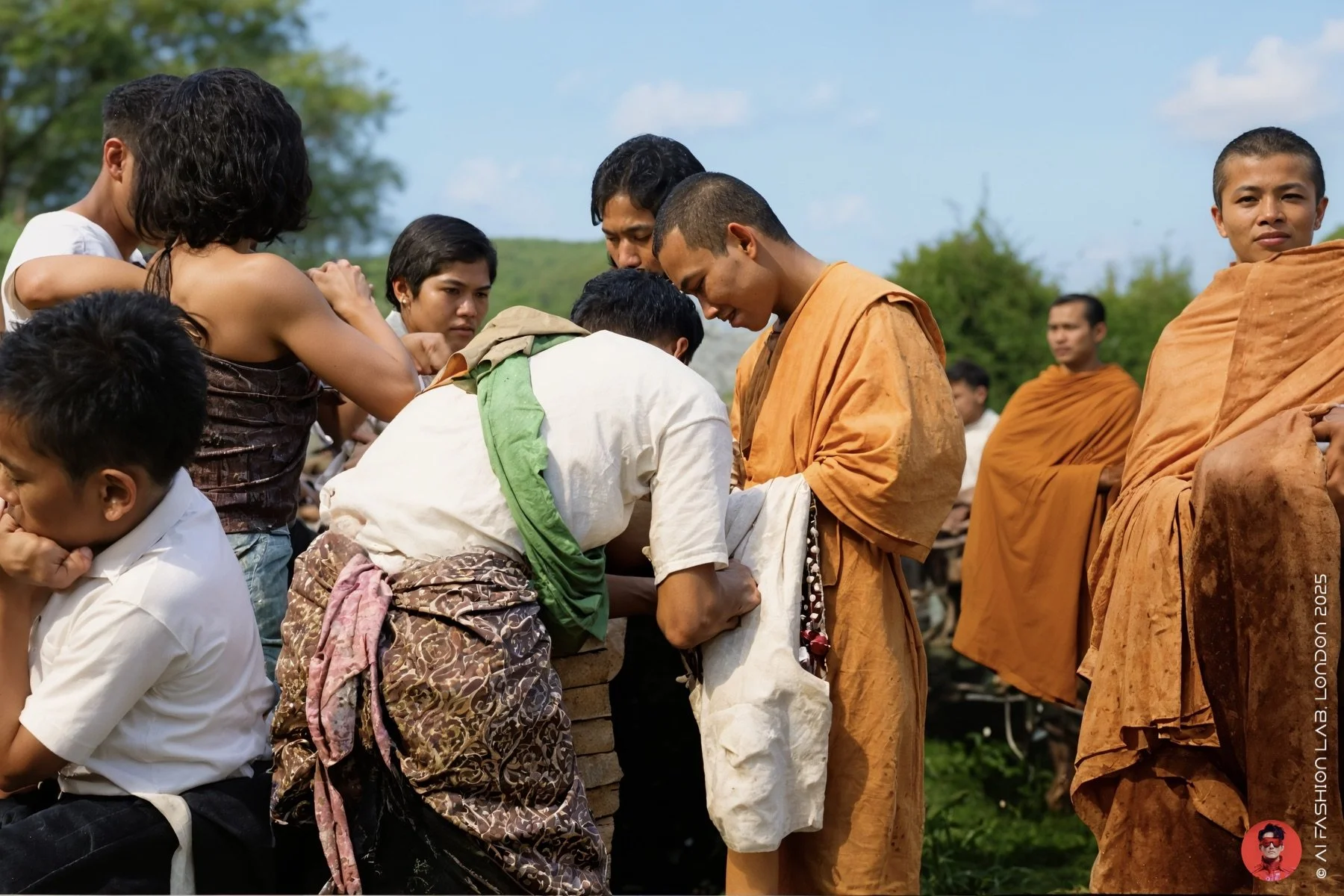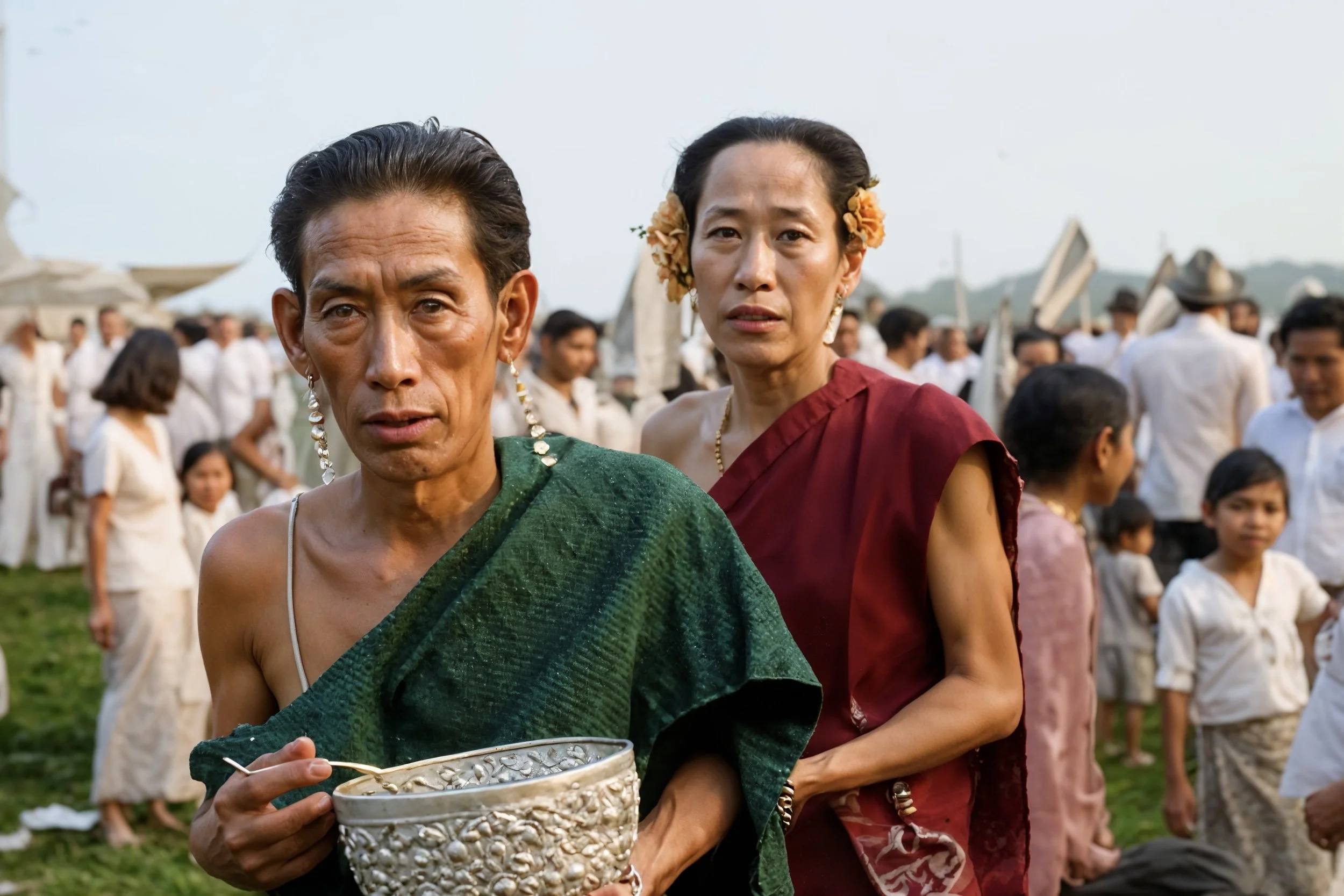สงกรานต์ที่สนามหลวงในสมัยรัชกาลที่ ๗
สงกรานต์ที่สนามหลวงในสมัยรัชกาลที่ ๗
แฟชั่น ประเพณี และการทำบุญตักบาตรในสมัยรัชกาลที่ ๗
ภาพที่ได้รับการบูรณะด้วยเทคโนโลยี AI ชุดนี้ มาจาก คุณอู่แก้ว สาณะเสน (Khun Ukaew Sanasen) ซึ่งถ่ายโดยคุณปู่ของเธอ คุณเอื้อ สาณะเสน (Khun Ua Sanasen) เป็นบันทึกภาพอันทรงคุณค่าของงานประเพณีสงกรานต์ ณ สนามหลวง กรุงเทพมหานคร ในช่วงปลายทศวรรษ 2460 ถึงทศวรรษ 2470 ซึ่งอยู่ในรัชสมัยพระบาทสมเด็จพระปกเกล้าเจ้าอยู่หัว (รัชกาลที่ ๗) ก่อนสงครามโลกครั้งที่สอง
เครื่องแต่งกายไทยโบราณ
ภาพถ่ายสะท้อนให้เห็นการแต่งกายของชายและหญิงไทยในสมัยรัชกาลที่ ๗ ฝ่ายสตรีนิยมสวม สไบ พาดไหล่คู่กับ ผ้านุ่ง หรือ โจงกระเบน สิ่งที่น่าสนใจคือมีบุคคลที่ดูเป็นผู้ชายแต่แต่งกายในแบบสตรีด้วย สไบ และ ผ้านุ่ง สะท้อนให้เห็นว่าช่วงเทศกาลสงกรานต์อาจมีธรรมเนียมการแต่งกายข้ามเพศเพื่อความสนุกสนาน หรือสังคมไทยในยุคนั้นมีความยอมรับในความหลากหลายทางเพศอยู่ในระดับหนึ่ง
ฝ่ายบุรุษในภาพถ่ายมีตั้งแต่การสวม เสื้อราชปะแตนสีขาวซึ่งเป็นชุดพิธีการและงานราชการ ไปจนถึงเสื้อผ้าฝ้ายสีพื้นธรรมดาคู่กับ โจงกระเบน โดยเสื้อผ้าสีขาวซึ่งพบได้มากในฝูงชน ไม่ว่าจะเป็นเสื้อราชปะแตนหรือเสื้อผ้าฝ้ายธรรมดา ล้วนสะท้อนถึงความนิยมในเสื้อผ้าสีอ่อนเพื่อความสบายในฤดูร้อน และช่วยสร้างบรรยากาศสง่างามในงานพิธี
การตักบาตรพระ
หนึ่งในกิจกรรมสำคัญที่ปรากฏคือการตักบาตร ซึ่งแตกต่างจากปัจจุบัน ตรงที่ข้าวสวยจะถูกใส่ลงใน บาตรโดยตรง ไม่ได้บรรจุในถุงพลาสติกหรือภาชนะปิด การถวายแบบนี้สอดคล้องกับพระวินัยโบราณ ที่พระภิกษุจะฉันอาหารทั้งหมดจากในบาตร
ความสำคัญทางวัฒนธรรมและประวัติศาสตร์
ภาพถ่ายเหล่านี้ไม่เพียงเป็นบันทึกเหตุการณ์สงกรานต์ในสมัยรัชกาลที่ ๗ (รัชกาลที่ ๗) แต่ยังเป็นหน้าต่างสู่วิถีชีวิตของสังคมไทยในช่วงต้นศตวรรษที่ 20 ถ่ายทอดทั้งรูปแบบการแต่งกาย พิธีกรรมการตักบาตรที่เปี่ยมด้วยความเคารพ และแง่มุมของการแสดงออกทางเพศที่ช่วยขยายความเข้าใจในสังคมกรุงเทพฯ ก่อนยุคสงคราม
Songkran at Sanam Luang in the Reign of King Rama VII
Fashion, Tradition, and Almsgiving in the Reign of King Rama VII
This set of AI-restored photographs comes from Khun Ukaew Sanasen, taken by her grandfather Khun Ua Sanasen. They are a valuable visual record of the Songkran festival at Sanam Luang, Bangkok, during the late 1920s to the 1930s (Buddhist Era late 2460s to 2470s), in the reign of King Prajadhipok (King Rama VII), just before the Second World War.
Traditional Thai Dress
The photographs show the attire of Thai men and women during the reign of King Rama VII. Women are seen wearing sabai draped over the shoulder, paired with pha-nung or jong kraben. Interestingly, there are individuals who appear to be male but are dressed in the style of women, with sabai and pha-nung. This suggests that during Songkran, cross-dressing may have been a festive custom, or that Thai society at the time had a degree of acceptance toward gender diversity.
Men’s clothing ranges from the formal white suea racha patan, worn for ceremonial and official occasions, to plain cotton shirts paired with jong kraben. The prevalence of white clothing in the crowd — whether formal suea racha patan or ordinary cotton shirts — reflects the preference for light-coloured garments for comfort in the hot season, as well as the dignified tone of the celebration.
Almsgiving to Monks
One of the key activities depicted is tak bat (almsgiving to monks). Unlike modern practice, steamed rice was placed directly into the bat (alms bowl) rather than packed in plastic bags or containers. This method is in accordance with traditional monastic discipline, in which monks would consume all the offerings from the bowl itself.
Cultural and Historical Significance
These photographs are not only a record of the Songkran festival in the reign of King Rama VII, but also a window into the lifestyle of Thai society in the early 20th century. They convey the styles of dress, the reverent ritual of almsgiving, and glimpses of gender expression that broaden our understanding of Bangkok society before the war years.
#aifashionlab #AI #aiartist #aiart #aifashion #aifashiondesign #aifashionstyling #aifashiondesigner #fashion #fashionhistory #historyoffashion #fashionstyling #fashionphotography #digitalfashion #digitalfashiondesign #digitalcostumedesign #digitaldesign #digitalaiart #ThaiFashionHistory #ThaiFashionAI #thailand










